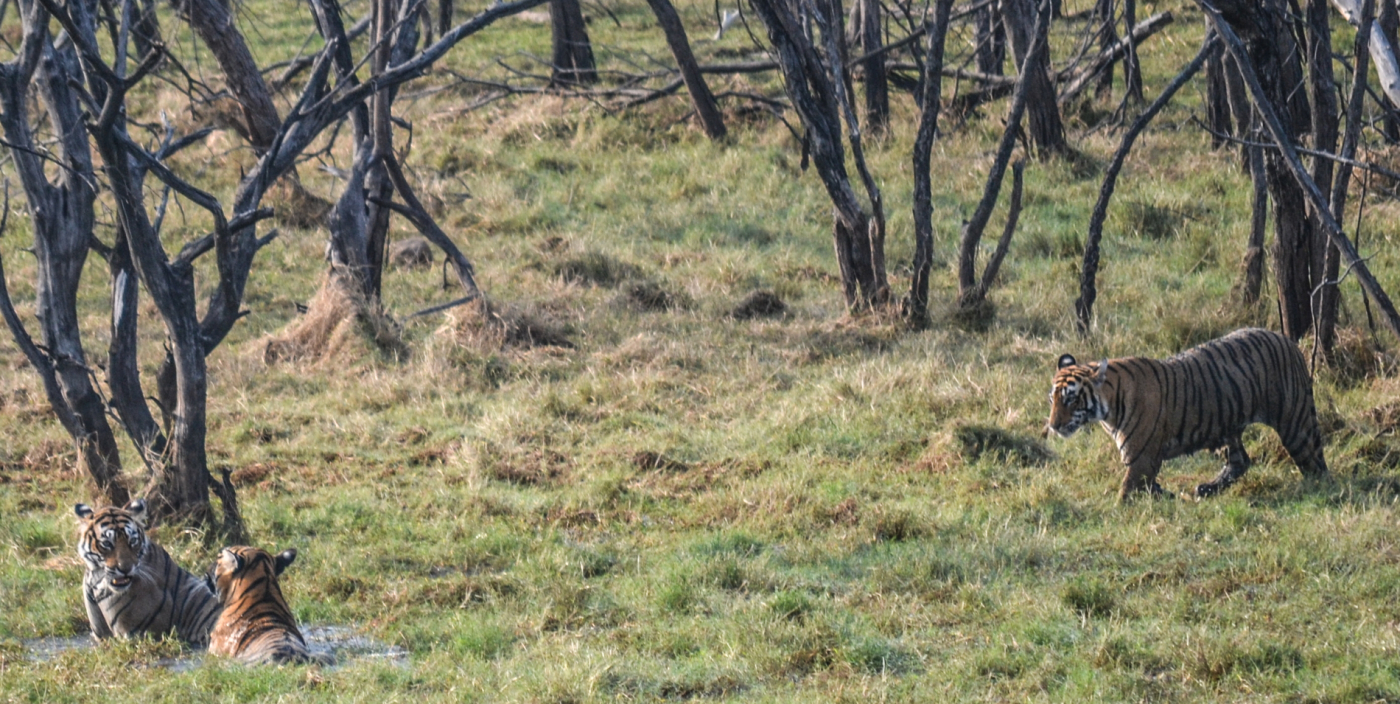
Where the wild things most certainly aren’t
George Reynolds goes on a tiger safari in Ranthambore and asks: “So … Where are all the tigers at!?”

George Reynolds goes on a tiger safari in Ranthambore and asks: “So … Where are all the tigers at!?”

You can see tigers in Ranthambore. You know, Ranthambore. National Park? Rajasthan? UNESCO-cherished fort up on a hill, overlooking the whole shebang, including a lake which on a clear day you can see crocodiles lazily traversing? Miles from a major city? Flanked by a strip-town of unappealing guesthouses and restaurants, streets teeming with litter and stray dogs and semi-domesticated pigs?
You can see tigers in Ranthambore. Like, purely theoretically, you can see them anywhere – even in London. You’re more likely to see them in a country where they live in the wild, like India, and in a park at least vaguely policed and with a population closely monitored by people with a vested interest in keeping them alive, like Ranthambore. You’re even more likely if you’re within one of the park’s 10 designated zones, each of which has its own gate and to one of which you’re assigned by lottery for your morning or afternoon drive – this lottery having taken place out of your sight at the hands of a number of government employees and underpaid park rangers. When you hear as if on the wind that you’re more likely still – most likely, really – to see them if you’re in two of those specific zones (no, I’m not telling you which ones) then that stuff about behind the scenes lotteries and government employees and underpaid rangers suddenly becomes super-relevant, because you realise – like so many processes in India – there is an alternative route to the goal you have in mind, the goal of seeing those tigers.
There are monkeys, of course, because this is India, and monkeys are ubiquitous, but if you’ve ever been on safari in Africa you know that once the guide starts talking about primates and wildfowl it means that all the good stuff has gone home for the day
You can see tigers in Ranthambore. And you’d better hope you do, because if you don’t, there’s precious little else. The scenery changes quickly from genuinely thrilling Kipling-esque jungle near the entrance – sunbeams slicing through shadowy canopy – to something more closely approximating Richmond Park, all long grasses and boring trees. The fauna is a total bust: chital, which are deer; and Blue Bulls, which are also deer (confusingly); some birds, which are not deer, but are just as boring. Leopards are a mere rumour; all your other Jungle Book #faves have scarpered hours before your chugging great jeep – or, even worse, a 20-seater lorry you can ride in at a discounted rate – has bludgeoned its way through the undergrowth fringing the track. There are monkeys, of course, because this is India, and monkeys are ubiquitous, but if you’ve ever been on safari in Africa you know that once the guide starts talking about primates and wildfowl it means that all the good stuff has gone home for the day. So it is here.

A sight so rare in Ranthambore
You can see tigers in Ranthambore. Well, you can certainly see evidence of them. Pawprints the size of side plates, tree trunks gouged like a giant’s chairleg, other hotel guests’ beaming faces as they come back practically fucking throbbing with tales of big cats stumbled upon – right there, just sleeping in the road. We could have watched for hours! You can hear evidence, too – panicked screaming high up in the foliage, the monotonous, relatively unperturbed alarm call of a Blue Bull or chital. And when someone elsewhere in the zone does see a tiger, you can see the effect it has on the jeeps next to you; as radio does not appear to be widely used, news of sightings is passed along in an implausible game of (apologies in advance) Indian Whispers – the guides holding a sotto voce conference as one group passes another on the path, the suddenly enthused guide exhorting the driver to step on it – cue a 20-minute bone-shattering transfer to the place the tiger might once have been but certainly is no longer.
You can see tigers in Ranthambore. Everyone there tells you so. But if you’ve been in India for more than a few days, you know that the last thing an Indian would ever want to do is court your displeasure – to the extent that they’d rather perform all sort of linguistic-syntactical loop-the-loops than be the bearer of bad news. And so you begin to unpick the sentence, really cross-examine its component parts. Note this is not the sober legalese of “may”, or the overly nebulous “might”. It’s something altogether more empowering – yes we can! – which at the same time makes no firm commitment in either direction. After a little more reflection, you realise that in this sentence, can is basically Atlas, shouldering an impossible burden of expectation
You can see tigers in Ranthambore. Because of course, we didn’t. We did, however, stay in a lovely hotel called the Aman-i-Khas, with pavilions for bedrooms and a personal batman for every guest and little cooling towels and fresh lemonade when you come back during the day and hot flannels and chai when you come back at night and excellent food and a darling little lake you can sit beside at sunset, watching the birds and moneys and insects constellate.
It’s just marvellous. It isn’t tigers. C